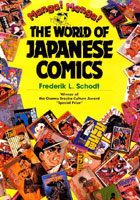
|
Akadot: How did you select the artists you showcased in Dreamland Japan such as King Terry, Shingo Iguchi and Reiko Okano? What made them stand out past the thousand other artists in Japan? FS: The artists were all people whom I personally found interesting. As mentioned earlier, I was also trying to showcase artists who were not so well known in America, but who were very individualistic. Earlier, with a friend named Leonard Koren, I had planned a book about the artists in Garo magazine, which has traditionally been one of the more avant garde magazines in Japan. That project never came to fruition, but I was very interested in Garo and its artists. So many of them are also featured in Dreamland Japan. Akadot: Your books Manga! Manga! and Dreamland Japan are massive amounts of information. How did you do so much research for them? FS: I spent years working on them. I seem to become involved in projects that take a long time, and require a lot of study. It's a learning process for me. I'm not sure I could call writing "enjoyable," since it is so hard, but I have certainly learned a great deal. For both Manga! Manga! And Dreamland Japan I read huge amounts of manga, and interviewed many people. In Dreamland Japan I was also able to incorporate information from years of interviews that I had done for a column I wrote on manga, in the Mainichi Daily News. Akadot: What made you become a translator? How has your background effect how you approach manga as a subject to study? FS: I make my meager living as a conference interpreter, but I have also done written translation for years, of everything from novels to manga to government speeches and computer manuals. When I lived in Japan, I loved to read manga for relaxation and entertainment, and I also found them a great way to learn about Japan and its culture, not to mention the language.
Want to read more?! Then check out Part II of Akadot's interview with Frederik Schodt coming soon. Links of Interest: Textbook for Manga 101: A review of Frederik L. Schodt's book Dreamland Japan: Writings on Modern Manga.
|
|||||
|
Frederik Schodt © Frederik Schodt webpage.
Dreamland Japan © Stone Bridge Press/Frederik L. Schodt.
Manga! Manga! The World of Japanese Comics © Kodansha International/Frederik Schodt/Osamu Tezuka.
|


